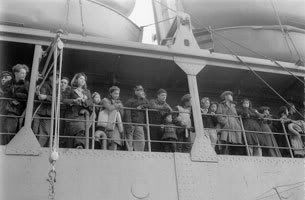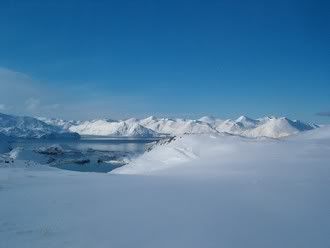
A Photo Safari of Wasilla, Alaska – Home of Sarah Palin.

Jun 01 2008
[crossposted on DKOS]
Life has never been easy for Unangans, an indigenous people of the Aleutians.
Recent archaeological investigation in the Unalaska area provides evidence that the Unangan (the People of the passes, according to linguist Moses Dirks) have inhabited the Aleutian Islands for at least nine thousand years.
The last thousand years seem to have been the worst.
The Russian Fur Traders: The Unangan culture thrived for centuries until the Russian fur traders discovered the Aleutian Islands around 1750. At this time, the Unangan population was estimated at 12,000 to 15,000. At first, they resisted the invasion, even resorting to warfare, but were eventually subjugated by the foreigners and forced to hunt sea otters and fur seals.
In the late 1700’s, the traders discovered the Pribilof Islands to the north were a rich source of hides, and forced a group of Unangans to move there to hunt for them.
The population of Unangan people was greatly reduced after Russian occupation due to disease, war and malnutrition.
World War II: In June 1942, nearly six months to the day after Pearl Harbor, the Japanese struck again on American soil. The bombing of Dutch Harbor signaled the beginning of the Aleutian Campaign and was quickly followed by the Japanese landing on Kiska and Attu Islands in the Western Aleutians, over 1,000 miles from Dutch Harbor. On Kiska, the Japanese took a small naval weather crew captive; on Attu, they took the whole village hostage, later shipping them back to Japan as prisoners of war.
In the aftermath of the Japanese invasion, U.S. authorities scrambled to get civilians out of the war zone. As a result, nearly 900 Unangan people were suddenly uprooted, evacuated from their homes with only a suitcase each, crammed onto crowded transport ships, and taken to internment camps in Southeast Alaska. They would remain in dismal, crowded conditions, suffering from disease and malnutrition, for three long years.

Courtesy of the National Archives: St. Paul residents gaze at their homes in 1942 as the U.S. Delarof pulls away from the dock, taking them to internment camps in southeast Alaska.
Somehow I bet most here knew only knew about later arrivals being incarcerated. Native Americans don’t get a whole lot of attention except when they are doing their native dances or something.
Today the total estimated population Unangans is estimated at 2,000.
Those 2,000 Unangans, as well as others who live alongside them, still like to eat and get around. Getting harder these days.
One answer in a place where there isn’t a whole lot of sun or even trees is geothermal. Al Gore may never have heard of geothermal but Unangans have.
The Unalaska Island is the site of deep drilling conducted for geothermal resources. In the 1980’s, there was an Unalaska Geothermal Feasibility Study prepared for Alaska Power Authority by Dames and Moore that comprised of an exploration program, consisting of three phases. The exploration program confirmed the existence of a highly productive geothermal reservoir at a depth of 1,949 feet, approximately 14 miles west of Unalaska/Dutch Harbor.
That’s mighty fine and all but this is way up north where it gets a mite difficult to get around in winter even yet.

VIEW OF UNALASKA FROM SKIBOWL MOUNTAIN (photo courtesy of S. Adams)
Some of the native fauna might help if they weren’t wild and a bit shy:

And too smart to go some places in the wintertime.
More pictures and other information on Unalaska can be found here.
So what to do about tapping the heat of Makushin Volcano where wild horses won’t go when it’s needed most?
Why the answer is so simple Al Gore might have thought of it if he had ever heard of geothermal power.
– Drill way down in the valley where the Unangans are.
Well you got to know where to drill and that is why there are some people who want to help, even a Republican or two who need votes something awful these days.
There is no shortage whatever of green energy.
There is a great lack of intelligence. Good thing there are Unangans who have lots of smarts. Needed it to survive in wild, beautiful country.
Best, Terry
May 19 2008
Everyone has heard about ANWR.* It is so well known that I do not have spell out the acronym. Ever heard of the Pebble Mine Project? Probably not. The major environmental organizations have done an extremely poor job of publicizing this disaster in the making. Pebble Mine is worse than anything the oil thugs want to do in ANWR and it is in the permitting stage, making it a critical issue in terms of time and public awareness. Please join me for an introduction to the proposed Pebble Mine Project.
*Arctic National Wildlife Refuge
Oct 16 2007
Cross posted at the Daily Kos under betson08
Blog Action Day coincides with Wolf Awareness Week. So I thought I’d startle you into noticing an issue that has been really bothering me since I first heard about it a month ago, and diaried it over at the Daily Kos here.
There have been important recent developments, so I thought I’d take advantage of the environmental theme of Blog Action Day to pass them on.
Who in the world would go up in a small plane and slaughter these majestic creatures, and how can we stop this?